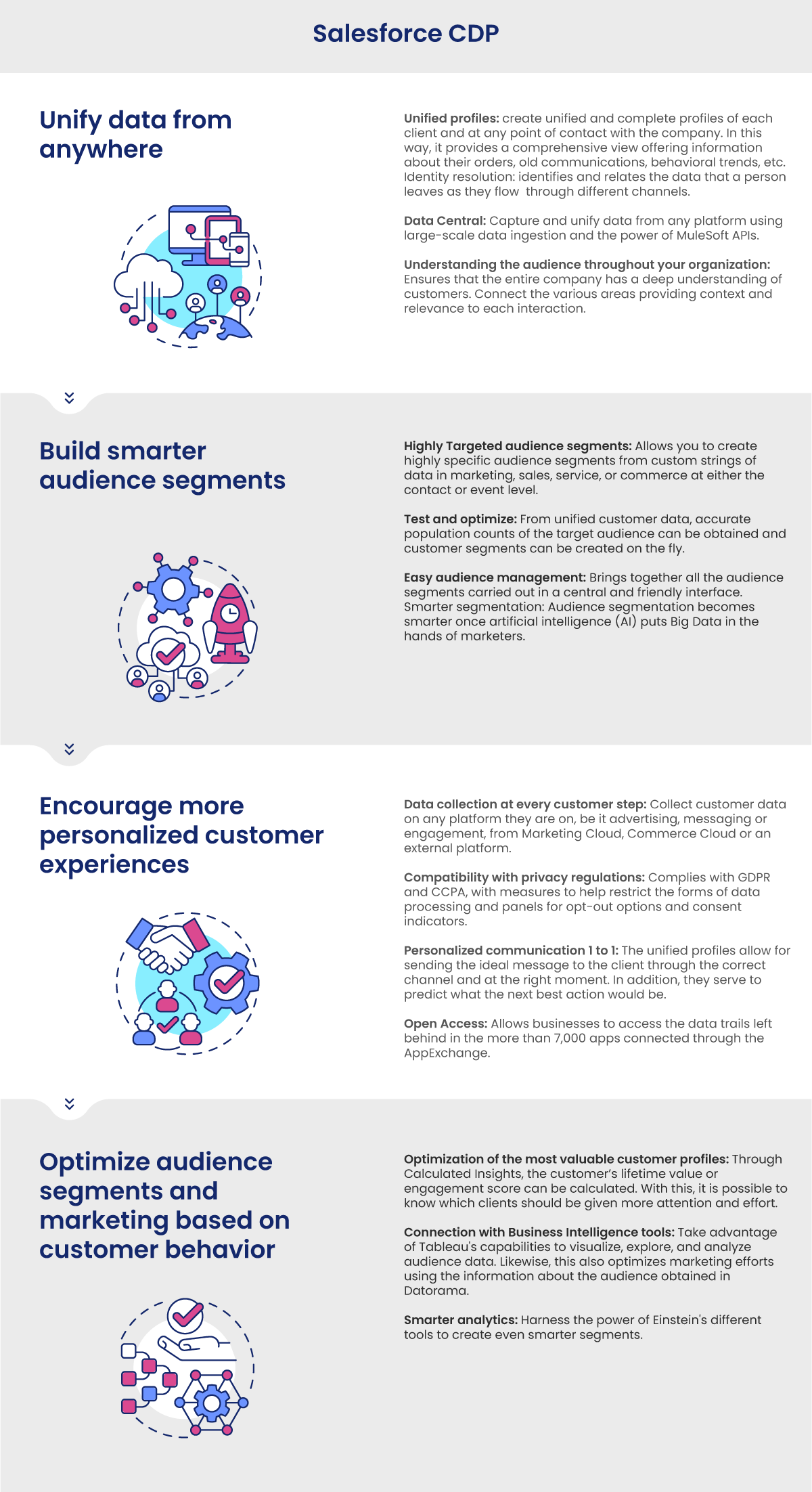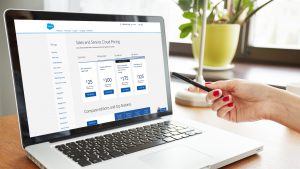Summer ’21 was the relaunch of Customer 360 Audience, which brought Salesforce CDP to the forefront. In previous articles, we explained what a CDP consists of and how it works, what the advantages of using it are, and we compared its innovative features with those of a CRM. Today we want to show you the process and tools by which Salesforce has provided Marketing Cloud with an incredibly powerful CDP that is integrated into the Salesforce ecosystem.
Salesforce, being number 1 in the world and recognized for its constant innovations at the service of the most modern business needs, could not help but launch its own CDP, with full integration with its other cloud solutions through the use of Customer 360. Now with Salesforce CDP, companies will be able to consolidate their data and turn it into a valuable source of information.
From this data, they will obtain unified and comprehensive profiles of each client, more effective market segmentations, and behavioral trends that allow a more hyper-personalized and fluid customer experience. Needless to say, this is the goal of every marketing professional.

What is a CDP and Why Use it in Your Company?
CDP establish a new marketing paradigm, now based on data and customer-centricity. They are basically a set of packaged software solutions designed to collect and combine customer data from all sources and finally create complete and unified profiles of each client.
What is Salesforce CDP?
Salesforce CDP is a suite of packaged software solutions designed to collect and combine customer data from all sources to create comprehensive, unified customer profiles. Now with Salesforce CDP you take full advantage of the capabilities of the software, combined with the potential of the customer relationship manager. In short, a higher level is reached where the data is more connected and its processing is more intelligent. This results in a powerful tool for marketing, but also for sales, support, and even the executives themselves.
Salesforce CDP enables companies to prioritize their own data over external data sources, ensuring a single source of information. This would facilitate the creation and implementation of hyper-personalized marketing campaigns and strategies in pursuit of customer loyalty.
What does Salesforce CDP do?
Salesforce CPD combines the essential features of a customer data platform with the capabilities and potential of a CRM. These are its main functions.

Benefits of Salesforce CDP
While Salesforce CDP caters to the most general purpose goals and tasks, it has significant advantages over its nearly 100 competing CDPs.
1- It is capable of acting as both types of CDP (Insight and Engagement). This way you can get rid of unnecessary expenses for customers who have already bought the product you intended to offer, and you can immediately make personalized and flexible offers in the price ranges that the customer typically accepts. Using this approach, you can increase the probability that they will interact with your offers by about five times. You will be able to classify customers into categories such as “loyal customers who spend more” or “customers who have stopped spending”.
2- Salesforce CDP effectively unifies and blends the granular behaviors of your customers online and offline, allowing you to compile activity and preference for each of them. This data can be easily analyzed and segmented based on up-to-date customer behavior and activated for the target audience, increasing the interest of current and potential customers. This is possible given a set of definable rules, as well as the use of Einstein AI.
3- It has the power to define and calculate multidimensional metrics from your data, so your marketing team will obtain information of extraordinary value.
4- It puts at your disposal a high-capacity segmentation capable of manifesting itself in 4 main areas:
- Geographical. The climate has a great influence on consumption styles in both clothing and food. Height influences the types of vehicles and equipment most in demand. The difference between rural or urban environments determines substantial changes in consumption patterns both in terms of products and frequency.
- Demographic. It is not possible to design personalized offers without knowing the age, gender, race, occupation, etc. of the target audience. How could you make a well-targeted offer of sports equipment, for example?
- Psychographic. Consider factors such as the beliefs and values of your potential customers. What would be the reaction of an Islamic community if they received an offer of pork? Probably similar to that of a Jewish community receiving a joint offer of meat and milk.
- Behavioral. Identifying when and on which products consumers are willing to spend their money is crucial. Holidays or dates with tax privileges are taken into account, and even the frequencies of consumption of basic products of each client.
5- Ensure that everything you run on your CDP is compatible with major systems and applications including: Salesforce Marketing Cloud, Service Cloud, Interaction Studio, Commerce Cloud, Datorama, and Loyalty Management, all of which are fully accessible by and from Salesforce CDP. If you already use these Salesforce products you can use Salesforce CDP through “native connectors” which allow you to integrate with Salesforce CDP without pre-coding. As if that were not enough, Salesforce CDP offers you integration with the AWS cloud (Amazon Web Services) and access to AppExchange with its available applications. In general, it guarantees a solid connection with any external application, including those of the ERP type.
Additionally, Salesforce CDP is constantly expanding its API, allowing your developers to integrate more freely and in real time with CDP.
6- It makes it easy to update your Information and allows you to save time. Salesforce CDP allows you to update your information through easy editing of its data model objects (DMO). In addition, it gives you the ability to copy and transfer complete segments with their description, information and filters, to new segments. It is not necessary to carefully review and re-enter the information obtained, saving time and effort.
7- It makes data collection and communication in the cloud easy for you: Salesforce collects data using the cloud information model (CIM). You can use various data sources, even with different structures and formats. Regardless of the source of information, this model standardizes data interoperability between cloud applications. The content of the model is organized into domains or subject areas, which in turn represent important business concepts.
In conclusion, Salesforce CDP has become a very powerful tool in the hands of marketers and organizations in general. It is capable of providing a 360 view of all customers, in a single, easily managed and intelligently segmented space. SkyPlanner, as a certified Salesforce consultant, has vast experience to help you implement the most viable and suitable CDP solution for your business. You can write to us at hello@theskyplanner.com



